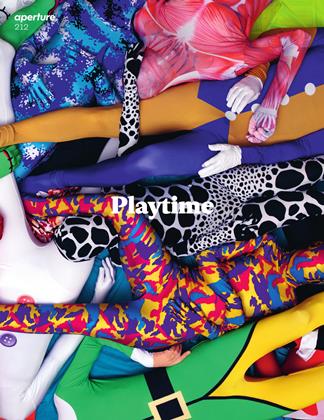Jo Ann Callis ca. 1976
Claudia Bohn-Spector
J'aime—je n'aime pas. —Roland Barthes
Human beings are shaped by desire. We hope and yearn for what we do not have, driven by thoughts of the people, things, and experiences we covet. Our longings may appear as cravings; conversely, they may crop up as but innocent ripples, pleasantly skimming the surface of consciousness. When sexually invested, our longings accelerate, unleashing powerful urges, fantasies, and erotic fixations. "My body is not the same as yours,” Roland Barthes once famously said, elucidating both the origins of our erotic attractions and the pulsating rush of human desire.
Jo Ann Callis’s color photographs from the mid-1970s take a fetishistic delight in human bodies. Naked, vulnerable, and tied in myriad places, the androgynous men and women in her pictures seem both enchanted and faintly repelled by the circumstances in which they find themselves. Callis was inspired by Pierre Molinier’s doll-like self-portraits and the twisted mannequins of Hans Bellmer, and her subjects attempt to enhance their pleasure in ways that are simultaneously playful and therapeutic, sticking their hands into pools of honey, tying nylon threads around their breasts, and rubbing their alabaster skin against luxurious fabrics. Faces are conspicuously and tellingly absent, buried in pillows or covered under waves of hair and a soft satin glove. A line along a woman’s back suggests a surgical incision mark, or the tingly sensation of fingers running down one’s spine. A heap of black sand sprinkled on skin conjures feelings of bliss or something more sinister. Callis is playing a game of what-does-this-feel-like, rendering physical sensations—sand, satin, hair, nylon, viscous honey on skin—in ways one might find erotically pleasing and titillating, or not. Rendered in photographic form, these double-edged fantasies achieve a degree of realism that is not for the squeamish, teetering as it does between the sumptuous evocation of physical delight and the sobering acknowledgement of emotional pain.
Callis has long exploited the photographic process to narrative ends. A teacher at the California Institute of the Arts and widely regarded for her conceptual work with three-dimensional objects and images of people in mysterious settings, she has worked both in black-and-white and color photography, sculpture, painting, set design, and digital imagery. While she uses the camera often, she never pursues the medium as an end in and of itself, employing it instead as a studio tool to capture the pleasures and terrors of female life. The resulting pictures are both seductive and unsettling, tantalizing visions of interior states that attest to Callis’s singular vision of the delicate tension between what feels good and what doesn’t, between what is desired and what is allowed. The photographs selected here are but a preview of Callis’s oeuvre: beautifully composed, with an unfailing eye toward color and texture, yet laced with the raw shivers of anxiety that run through her work like a chilling undercurrent.
Claudia Bohn-Spector is an independent writer and curator living in South Pasadena, California.
 View Full Issue
View Full Issue
More From This Issue
-
 Pictures
PicturesSwiss Mess
Fall 2013 By Bruno Ceschel -
 Pictures
PicturesKazuyoshi Usui: Showa 88
Fall 2013 By Ivan Vartanian -
 Pictures
PicturesJames Mollison: Playgrounds
Fall 2013 By Chris Boot -
 Words
WordsMusic I've Seen
Fall 2013 By Frances Richard -
 Pictures
PicturesBruno Munari's Light Games
Fall 2013 By Maria Antonella Pelizzari -
 Words
WordsPlaying Around Photography
Fall 2013 By Robin Kelsey
Subscribers can unlock every article Aperture has ever published Subscribe Now
Pictures
-
 Pictures
PicturesGabriel Orozco
Fall 2019 -
 Pictures
PicturesMickalene Thomas: Orlando Now
Summer 2019 By Antwaun Sargent -
 Pictures
PicturesMari Bastashevski State Business
Spring 2014 By Daniel C. Blight -
 Pictures
PicturesFouad Elkoury
Summer 2018 By Kaelen Wilson-Goldie -
 Pictures
PicturesRegina Silveira Enigmas
Summer 2014 By Sarah Hermanson Meister -
 Pictures
PicturesHudinilson Urbano Jr.
Summer 2014 By Tobi Maier








